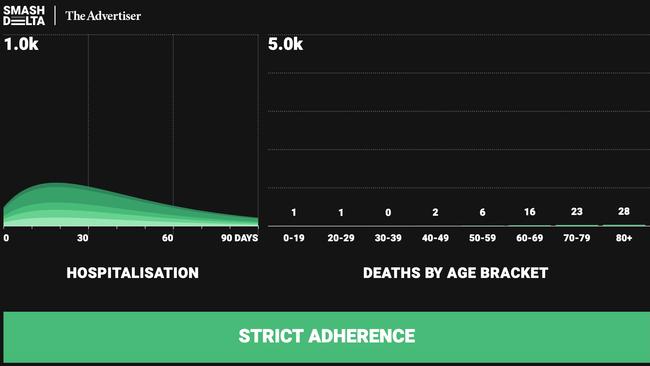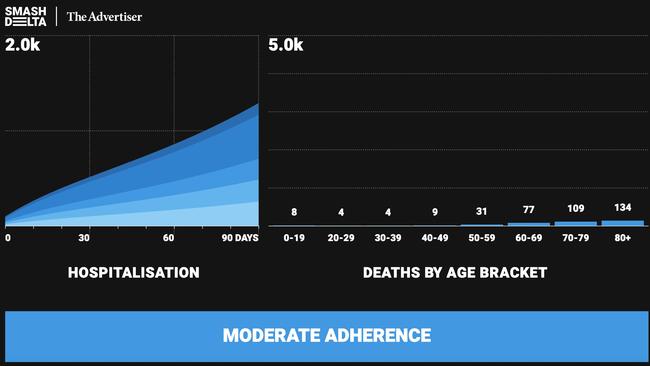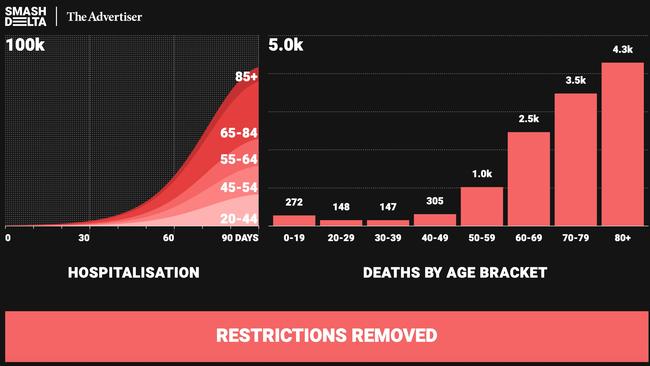Modelling by Smash Delta shows COVID-19 would kill 12,000 in SA without social distancing
Social distancing and restrictions is predicted to save 12,000 people over the next 90 days in SA, independent modelling of COVID-19 rates show.
Coronavirus News
Don't miss out on the headlines from Coronavirus News. Followed categories will be added to My News.
Modelling of COVID-19 infections, hospitalisations and deaths in SA over the next 90 days shows strict adherence to social distancing measures could save up to 12,000 lives.
In the best-case scenario, the number of lives lost could possibly be kept under 100.
In the worst-case scenario, the hospital system could be rapidly inundated and 12,000 people could die within three months, including 550 under the age of 40.
Social distancing measures have flattened the curve, but hospitalisations are steadily increasing, forecast to reach 1200.
Sydney data strategy firm Smash Delta, which has worked on NSW state government projects, used globally accepted methods to forecast our state’s COVID-19 future.
Their figures come ahead of Federal Government modelling expected this week.
Smash Delta managing director Ben Morley-John hoped the projections would help South Australians understand how bad things would get without social distancing.
“We are counting on everyone to take this seriously,” he said. “If they can see what future scenarios look like and how their behaviour can put the healthcare system at risk and the public at risk, then hopefully that might influence people to change.”
The team of data analysts created three different social distancing scenarios: “none”, “some”, meaning half the population adheres to appropriate measures, and “strict”, meaning everybody complies, while 20 per cent of the population still has to leave home to do essential work.



Likely death rates were calibrated to SA’s demographics, using Census data. A risk profile was developed for each age group. In the “some” scenario, where half the population practises social distancing properly, 300 deaths are estimated. In that scenario, potential for collapse of the health system remains, as the number of infections is still increasing after 90 days.
SA Salaried Medical Officers Association president Dr David Pope, an emergency specialist at Lyell McEwin Hospital, said “we’re facing a disaster” so people need to stay home to limit potential deaths.
“If our health system is strained to the point of collapse, then any medical problem becomes life threatening when it wouldn't normally be,” he said.
“It's absolutely essential that we prevent that happening. We can't fix it when people get really sick (with COVID-19), so the community has to distance themselves, so that our health system does not collapse. Without that it will, and that will have devastating effects for everybody.”
He said the Smash Delta modelling would come as “no surprise to the state’s health authorities or anybody with epidemiology knowledge”.
“The better the public understand, the more everything will make sense to them.”
UniSA biostatistics expert Professor Adrian Esterman said the type of modelling used by Smash Delta, known as Susceptible Exposed Infectious Recovered (SEIR), was the gold standard “developed by Imperial College London, who are some of the gurus at infectious disease modelling”.
“ If it persuades the recalcitrants … to do the right thing, it may be helpful as a public health message,” he said.

